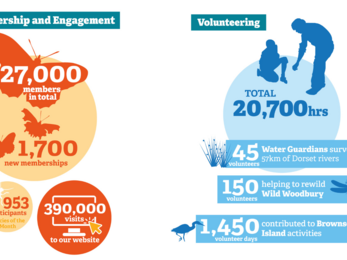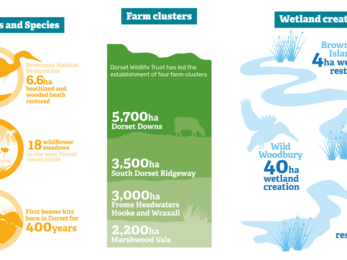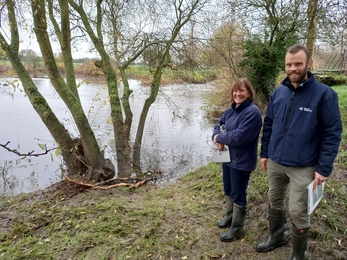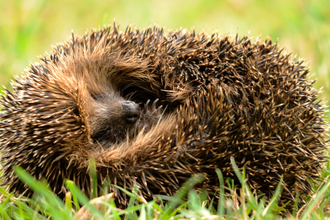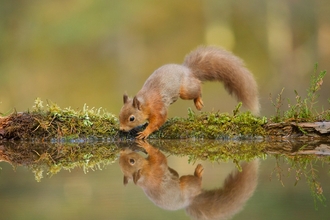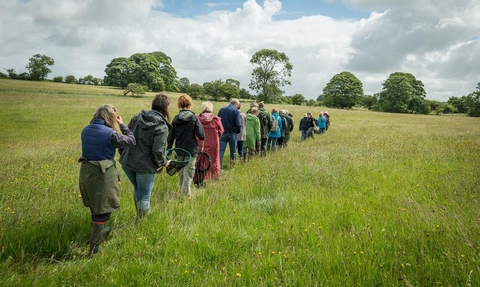
Dorset Wildlife Trust Image Library
Annual Review 2023 Making a difference for wildlife and people
From the Chief Executive
I am very proud of our achievements over the year and the progress we have made towards achieving our goals of 30% of land and sea being managed in favour of nature and one in four people taking action for nature by 2030. This report showcases some of those achievements and clearly demonstrates how the work of Dorset Wildlife Trust and our supporters is making a difference for wildlife and people across Dorset and Bournemouth, Christchurch and Poole.
The progress we have made in working with farmers and landowners is particularly notable. Dorset Wildlife Trust has played a key role in establishing four new farm cluster initiatives, helping deliverlandscape-scale conservation gains across 14,000 hectares of Dorset’s countryside. We also reached the amazing milestone of 100 hectares of species-rich meadows created in west Dorset over recent years, a direct result of our farm liaison work in the area.
Dorset Wildlife Trust played a leading role in the development of the Wareham Arc Landscape Recovery project. Working with the RSPB and National Trust, the initiative brings together a broad coalition of farmers, wildlife charities, Forestry England and Natural England to revitalise historic wetland and heathland habitats across 3,800 hectares in Purbeck.
Dorset Wildlife Trust nature reserves continue to play a major role in biodiversity conservation, increasingly serving as nature-rich hubs supporting the delivery of nature recovery networks. Our reserves have also made significant contributions to species recovery with heath tiger beetle and ladybird spider expanding in range andnumbers, to name but a couple of success stories.
In June 2022, it was discovered that beavers had bred in Dorset for the first time in over 400 years, when a young kit was spotted exploring its watery surroundings within Dorset Wildlife Trust’s en[1]closed Beaver Project site.
Volunteer support is so vital to our work and over 100 new volunteers are now taking action to tackle the ecological crisis. The ‘Water Guardians’ project, supported by Wessex Water, has attracted 45 volunteers to survey nearly 60km of rivers in Dorset. We now have 150 registered volunteers helping to transform the landscape and make space for nature at Wild Woodbury.
The cost of living crisis has presented significant fundraising challenges. Membership recruitment has been difficult throughout the year but we have welcomed some 1,700 new membersmaintaining our membership at over 27,000. This combined with some very generous legacies has put us in a strong position.
None of our work would be possible without the generous support of our members, volunteers, partners, donors and grant funders or the passion and dedication of our Board of Trustees and our staff. Thank you to everyone who has helped to make a difference for wildlife and people in Dorset.
Brian Bleese
Chief Executive
From the Chair of Trustees
Dorset Wildlife Trust is a membership-based organisation and building and supporting the membership is a priority. The relatively high number of members has remained almost constant over the past year, despite the cost-of-living crisis. However, engaging more people is arguably the most important of our strategic objectives. Hopefully, more will decide to become members. Regardless, we have a key role in raising awareness, understanding, and a hunger for action to meet the challenges of the climate and ecological emergencies. And we need to reach out to communities beyond our traditional conservation-orientated membership. Growing our engagement with the people of Dorset is at the heart of our purposes.
The future of Dorset’s environment and wildlife is uncertain at best, and dire at worst. Several factors are working together to create an unprecedented level of threats. Firstly, climate change is already adversely altering habitats more rapidly than models have generally predicted. Secondly, increasing regional economic growth is bringing intense pressure on land and its ecology. Thirdly, public policy has reduced the effectiveness of regulation by withdrawing inspection resources, alongside an intent to dilute statutory protections. Fourthly, the agriculture sector is coping with hesitant and much-altered post-Brexit support arrangements. In this context, we must and will step up and speak out more strongly for nature and the environment.
Since its foundation, more than 60 years ago, a core activity for Dorset Wildlife Trust has been acquiring and managing nature reserves, of which there are now more than 40. Judiciously adding to these reserves remains an important task, as does their effective management. However, we and others have a large portfolio of traditional reserves and there are fewer opportunities to acquire new ones. This is why we are growing a new strand of activity, which is acquiring land that has limited existing biodiversity and managing it to increase the abundance and diversity of wildlife. Wild Woodbury has shown us the way. We are targeting further similar developments, supported by the great generosity of donors, access to nutrient offset funds and successful grant applications.
The above can only be achieved if Dorset Wildlife Trust is well-governed and has a sustainable economic foundation. The trustees continue to review and enhance our governance. The staff are our greatest asset and supporting them is fundamental to our longer-term success. We have been able to prudently increase our staff numbers over the past year.
The trustees thank the Chief Executive and all employees for their dedication and exceptional output, often delivered in challenging circumstances. Finally, I thank the trustees, volunteers, all members, and the many individuals and organisations who have provided financial and other support for our important work.
Mark Kibblewhite
Chair of Trustees
Our finances
From creating new habitat for heath tiger beetle and ladybird spiders to launching the Water Guardians scheme, it has been a year of innovation and achievement. Read more about just a few of our projects which are helping Dorset's wildlife to thrive.
Farm clusters
Farm clusters are ideally placed to work with Lawton principles, with individuals looking beyond their farm boundary to ensure that ecological networks are 'bigger, better, and more joined up'. There are lots of different approaches to landscape-scale conservation but working with ‘clusters’ of neighbouring farmers across a landscape has been proven to deliver joined-up thinking leading to large-scale conservation gain. Farm clusters begin under the guidance of a lead farmer who brings neighbours together, then a trusted conservation advisor or facilitator of the group is chosen. Dorset Wildlife Trust currently facilitate four farm clusters in Dorset covering over 14,000 hectares. Each farm cluster has its own unique objectives set to suit their landscape character, priority species and habitats. Expert advice is then coordinated to deliver on farm site-specific training on how best to protect these assets in the farmed environment. Dorset Wildlife Trust facilitators further support clusters through delivery of coordinated surveys of species and habitats with the aim of building locally defined Nature Recovery Strategies. In one cluster, 40 hectares of new priority habitat was identified, and new species records showed it to be of regional importance for specialist farmland wintering birds. This new data determines key areas for restoration and creation of habitat within the cluster which will link and strengthen existing wildlife corridors. The value of farm clusters has been bought to the fore in recent years, as new Agri Environment Schemes take the place of historic area payments. With this change comes uncertainty, and for many farm businesses the need to adjust their systems. Being part of a farm cluster provides a mechanism of support through this change by reducing risk via shared learning and exchange of ideas.
Rewetting Wild Woodbury
We’ve embarked on a groundbreaking restoration of the headwaters of the River Sherford which re-evaluates our relationship with water on the land.
Rewilding is all about establishing natural processes to create a more sustainable dynamic landscape. But to do this we first have to undo some of human’s past interference. Wild Woodbury is nestled by the village of Bere Regis, the ‘Bere’ part of the name is thought to mean ‘wet wooded valley’ and that isn’t a half bad way to describe what the land there is desperate to be. When Dorset Wildlife Trust purchased the land in 2021 however there was a problem, the entire headwaters of the River Sherford, a landscape full of springs, desperate to be wet, was excessively drained. The network of subterranean field drains and deep straight field edge ditches were designed to do one thing; to get water off the land as quickly as possible and out to sea. Now, this presents many issues which are becoming more and more apparent as we suffer the implications of climate change, bio-diversity loss and intensification of land use:
1. As our country becomes more and more susceptible to drought, this practice deprives us of vital sources of water.
2. The opposite is true when water is plentiful, by removing water from the upper catchment as quickly as possible, we make flooding downstream all the more likely.
3. Poole Harbour (a highly designated and important place for wildlife, livelihoods and wellbeing) is being polluted by excess nutrients that reach the harbour faster and faster.
4. We are deprived of complex wetland habitats where wildlife thrives. Through detailed studies and planning we have undertaken a ‘stage-0’ restoration on site which undoes past drainage, allowing water to find its own path. The land acts like a sponge; holding and storing water when plentiful and releasing it more slowly which will protect against drought. By slowing and spreading the flow, excess nutrients are removed by plant life meaning we release cleaner water downstream to the harbour. Already in the first year, the return of wildlife to these wetter areas has taken us by surprise and we cannot wait to see what will call Wild Woodbury home in the future.
Underwater discoveries
The difficulties of understanding what’s happening even a few metres off our shores cannot be underestimated, yet a band of volunteer divers have been revealing hidden treasures and highlighting issues in Dorset’s marine environment for nearly three decades. Dorset Seasearch started out in 1995 with a few experimental dives around Kimmeridge Bay. Since then, more than 550 volunteers have spent a total of 2,500 hours underwater, helping us to appreciate what is important in Dorset’s seas. Two names stand out – Lin Baldock and Mike Markey between them have racked up over 400 dives since 1996 – and are still going strong.
A few highlights from the 2022 diving season give a flavour of what Seasearchers get up to:
Nudibranch (sea-slug) spotting - Mike Markey photographed a rare white sea-slug, Amphorina linensis in Swanage Bay and Steve Trewhella spotted the tiny Trinchesia genovae in Portland Harbour – a first for England.
Fishy encounters – there were several sightings of spiny seahorses throughout the year from Portland Harbour and Ken Burden filmed a large anglerfish near a First World War shipwreck in Poole Bay. Lin Baldock somehow spotted and photographed a very cryptic pair of Europe’s smallest fish – Guillet’s goby, nesting under a shell among shelly gravel off Bat’s Head.
Seabed scars – divers investigated the site of a cruise ship anchorage in Poole Bay during the covid lockdown. A year after the last cruise ship departed, they found a wide sandy gully banked by mounds of chalk rubble and overturned ross-worm clumps.
Detecting change – Seasearch divers re-visited a site on Lulworth Banks to gather high resolution 3D imagery. This made it possible to monitor the fate of long-lived, delicate species such as the ross coral.
Bringing it all to life - nearly all divers now carry cameras and the images they bring back go beyond just providing a record of species and habitats – they reveal the delights of this inaccessible world to those of us restricted to land.
The difficulties of understanding what’s happening even a few metres off our shores cannot be underestimated, yet a band of volunteer divers have been revealing hidden treasures and highlighting issues in Dorset’s marine environment for nearly three decades.
Wild Seas Surveyors
Surveying and monitoring habitats and species is vital in informing decision-making and provides a great opportunity for people to play an important role in nature conservation. A new team of seashore and shallow water surveyors, based at the Fine Foundation Wild Seas Centre, has been created to offer people the opportunity to help with our marine work in a practical way.
Over the winter, a new volunteering opportunity was launched as part of our marine work and the Wild Seas Surveyors volunteer team was created. These volunteers will help Dorset Wildlife Trust to carry out a number of seashore and shallow water surveys. While most of the surveys are run from the Wild Seas Centre in Kimmeridge Bay, others cover a variety of locations along the Dorset coast. The surveys currently include monitoring the newly arrived furrowed (Montagu’s) crab*; recording the astonishing snakelocks anemone bed in the Kimmeridge Bay shallows, which is possibly unique in size; carrying out the Wildlife Trusts’ national Shoresearch surveys; and monitoring peacock’s tail seaweed which is a feature of the Purbeck Coast Marine Conservation Zone.
*Furrowed crabs, whilst a native species, have undergone a population explosion in recent years in Cornwall and Devon, and were first recorded in Dorset in 2019. From low numbers a couple of decades ago, they have become the dominant crab on Cornish seashores, with concerns about the potential impact on longer-term residents such as the edible crab.
The response to our appeal for survey volunteers was sooverwhelming that we had to close the recruitment early. This area is obviously one that appeals to many people and offers them a unique opportunity to get involved in our marine work in a practical way. A programme of volunteer training will hopefully see this team develop its skills and knowledge so that we can add further surveys and include new locations along the Dorset coast and extend the offer to an additional group of supporters.
Water Guardians Community Project
The Water Guardians community project has been established in partnership with Wessex Water to help with the proactive monitoring of our waterways to quickly report pollution. It aims to promote cleaner water and good quality habitat for wildlife, whilst enabling volunteers to foster a sense of stewardship for our rivers.
Water Guardian volunteers are trained to spot and report pollution, invasive non-native species and wildlife sightings along individually assigned stretches of river. Their stretches of river are accessible by footpath and are local to the volunteer, enabling them to take part and get a sense of pride in looking after watercourses near to where they live. In 2023 they will be supported to run local community events, such as pulling Himalayan balsam (Impatiens glandulifera).
A large percentage (87.2%) of the volunteers engaged in this project are existing Dorset Wildlife Trust members, though many were not engaged in volunteering for the Trust (69%). This project has caught members’ interest and inspired them to stand up for protecting their rivers.
So far, there are 45 Water Guardian volunteers, covering 56.81km of river along Dorset
footpaths. The River Stour has the most coverage, 20.9km, by 15 volunteers and the average distance walked by Water Guardians across Dorset is 1.5km. Water Guardians are asked to report both negative and positive pollution survey results. As of 31 March 2023, we have received 169 negative returns (no pollution spotted) and 21 positive pollution returns (possible pollution spotted, that requires more analysis). The positive pollution incidences are reported to Wessex Water and are tested on site, within two hours and investigated further where needed.
November 2022 saw a poignant moment in wildlife reporting. A North Dorset Water Guardian reported a suspected beaver field sign in the Upper Stour. This was followed up by a site visit from the Rivers Team Conservation Officers, Steve Oliver and Colleen Smith-Moore. The first confirmation that Dorset has a free-living beaver population in over 400 years! One amazing Water Guardian has said that she noticed these signs, as being part of this community project has encouraged her to pay closer attention to the river.
Wild Paths
The National Lottery Heritage Fund (NLHF) ‘Skills for the Future’ funding programme was launched in 2009. It aimed to fund high quality work-based training opportunities to equip people with the skills to pursue a career in heritage and enhance the capacity of the heritage sector to deliver training and share good practice. The programme also had the goals of demonstrating the value of heritage skills to modern life and increasing the diversity of the heritage workforce. Between 2009 and 2022, Dorset Wildlife Trust led the delivery of over 110 traineeships.
The final stage of the Skills for the Future’ programme was the Wild Paths project led by Dorset Wildlife Trust on behalf of five Wildlife Trusts in the south west. Central to the Wild Paths programme was the desire to develop new, more diverse talent to enrich the nature conservation sector. Methods to recruit people into the Wild Paths trainee placements were made as inclusive as possible and were more successful than anticipated. 605 eligible applications were received over the three years, of which 206 candidates were invited to informal, practical selection days and assessed against need, enthusiasm and aptitude. 31 candidates were successful in securing trainee placements. 77% of trainees recruited were from backgrounds traditionally underrepresented in the natural heritage workforce, for example with a disability or long-term health condition, from ethnic minority groups and those not educated to degree level. This level of interest in the traineeships showed a real demand for inclusive entry level opportunities and a non-academic route into nature conservation. All candidates have gone on to secure paid employment in the sector.
The Wild Paths initiative was independently reviewed by an external evaluator, Heritage Insider, who described the project as ‘having a career-defining impact for trainees who may otherwise have struggled to get into the conservation sector. The majority of whom continue to professionally grow and flourish within the sector. The impact and value of this opportunity cannot be underestimated.’
Wild Paths has been described by the National Lottery Heritage Fund as an exemplar project and the final
report used as an example of good practice in evaluation and reporting.
Enclosed Beaver Project
In June 2022, it was discovered that beavers had bred in Dorset for the first time in over 400 years, when a young kit was spotted exploring its watery surroundings within Dorset Wildlife Trust’s enclosed Beaver Project site.
Eurasian beavers Castor fiber were once widespread across freshwater habitats in the UK and are slowly making a comeback having been hunted to extinction around the 16th century. The adult pair released by Dorset Wildlife Trust in February 2021 have successfully bred at their first opportunity, and there is now a family of five at the enclosed project site. Beavers can breed once a year, and this is a clear sign that these semi-aquatic rodents are healthy and happy in their Dorset home.
Mating occurs during the winter months and the three young beavers, known as kits, were born in spring 2022. They would have spent the first month of their lives within the safety of the lodge, an underground tunnel and chamber system where these mostly nocturnal mammals rest during the day. At a month old, kits start to emerge and explore their freshwater surroundings, and to much excitement, the first footage of one of the youngsters was captured by a trail camera at the project site in June 2022. Beavers are social animals living in small family groups consisting of a dominant breeding pair and two generations of young, so there is potential to see another litter of kits born in spring 2023, which will be another sure sign that the animals are thriving.
Beavers are often termed ‘ecosystem engineers’ due to their ability to coppice trees, build dams and create increasingly complex and diverse wetlands. They are very much a keystone species, with their habits having a dramatic effect on other wildlife, enhancing biodiversity. This scientific study site is exploring the impacts beavers have on their environment, helping to increase our awareness and understanding of what it means to have these magnificent creatures back in a local landscape.
Urban Green
With funding from the National Lottery Community Fund, the Urban Green project worked with five disadvantaged communities across Poole and Bournemouth to enable access to high quality greenspace and to enable people to benefit from regular contact with nature.
Urban Green has had a huge impact on people’s lives, demonstrating the value and benefits of regular contact with nature. One of the biggest impacts of Urban Green has been in building knowledge and confidence within lead organisations and volunteer groups. The Trust’s expertise in creating and managing spaces for wildlife and nature is highly valued and has been the biggest strength of the project.
The Urban Green project showed how difficult but beneficial it was to engage teenagers and set out to overcome the difficulties by creating activities which appealed more to this generation by linking with art and film projects. One of the aims of the project was to increase people’s sense of wellbeing by being actively involved in improving local spaces for wildlife. The benefits of being involved in a nature-based project has been documented, by the anecdotal and interview responses gained from many of the people involved.
“We’ve got this great community, every week. People come from various places, from Rotary, the church, general public. Lots of different people getting involved, and doing what they can. It’s been a social thing as well, helping the community.” (volunteer quote from St Peter’s Reimagined film)
“I bought along a couple of local lads, who are struggling at school and getting into trouble. But here they really thrived. And it wasn’t just the impact on them and their wellbeing by being involved, but actually the wider impact on the family as well, that it kind of gave them a bit of hope that there is something else that they could do” (volunteer)
“It’s the expertise (from Dorset Wildlife Trust). We came here as complete novices, we didn’t know anything about anything and we’ve learnt such a lot. And it’s been really brilliant. They were so kind and patient.” (volunteer)
Species recovery across Dorset Wildlife Trust reserves
One of the aims of the Wilder Dorset by 2030 strategy is to showcase nature’s recovery. Our nature reserves provide vital reservoirs of rare and important species, both in a Dorset and a national context. Over the last year we have seen just how nature can recover if given the opportunities to do so.
Heath tiger beetle is a species found on only a handful sites across the south of England, its population estimated to be half that of 25 years ago. In Dorset, our Sopley Common reserve has one of the largest populations of this species. The vital piece of the habitat puzzle for this species is bare ground. It is needed not only for hunting adults but for the predatory larvae that live burrowed into the sand. We have been working to create the perfect mosaic for the species and there is now 15% more bare ground on site than 10 years ago. Our efforts have been rewarded, with 2022 seeing the highest count for 12 years and 60% of those individuals recorded were on new scrapes. These bare ground scrapes provide amazing habitats for some of our other overlooked rare invertebrates, including mottled beefly.
Ladybird spider is the rarest spider in the UK, thought to be extinct in the UK until the 1980s when it was rediscovered in Dorset. Dorset Wildlife Trust has been working with partners over the past 15 years or more to recover the population of this beautiful spider. Through creation of the correct habitat structure, microclimatic conditions and translocations, Dorset Wildlife Trust sites supported around 30% of the UK population in 2022, with the range of the species increasing.
Pillwort is the UK’s only native aquatic fern, with the only Dorset colony on Dorset Wildlife Trust’s Winfrith Heath reserve. Our work to create shallow, seasonally inundated pools has been helping to ensure the species thrives. The species has increased its range across the site, spreading into the newly created pools.
Heathland and wetland restoration and creation on Brownsea Island
In September 2021, we embarked on an ambitious island-wide project with the National Trust to restore and improve key habitats on Brownsea Island. A project of this scale hadn’t been seen on Brownsea before and required careful planning and collaboration to ensure that it ran smoothly with the additional challenges posed by island logistics. Dorset Wildlife Trust was aiming to restore and create 6.6 hectares of a mix of lowland heathland and wooded heath, as well as improve wetland habitat in both the reedbeds and lagoon with a fully funded capital project of over £240,000.
Heathland restoration is a priority habitat for the UK and Dorset in particular, but Brownsea Island is unique to the rest of Dorset in that red squirrel habitat is also an important factor. Wooded heath creation, like in the Caledonian forests of Scotland, provides suitable habitat for both squirrels and heathland species.
Creating areas for heathland and wooded heath involved large-scale felling operations across the reserve with extraction of suitable timber off the island to be used in industry, then mechanically scraping and removing the humus layer so that heather had a chance to establish. Brownsea’s past rhododendron cover means that most of these areas are left with very little chance of heather establishing without removing the litter layer left behind.
Just a year after the project started, heather was already sprouting abundantly into most areas, proving that heather seed had remained locked away waiting for the right conditions to establish. A rainy September after a very dry summer set it all growing in just a couple of months.
Wetland creation in both the reedbeds and lagoon involved four new scrapes and restoring the water network into the main reedbed which is an essential water supply for the brackish lagoon. Two new scrapes were created in the lagoon in February 2022 which will be viewed from The Lookout when the new hide opens next year have already been frequented by waders and wildfowl species. The two new scrapes in the reedbed can be viewed from the reedbed hide and are already visited by more wildfowl than observed the previous year, showing encouraging breeding behaviour
Wildflower meadow creation
Harvesting wildflower seeds in west Dorset has helped create 100 hectares of vital habitat. We were honoured in March to have David Attenborough choose one of Dorset Wildlife Trust’s meadow
restoration projects to stage the first Wild Isles grassland piece-to-camera and, true to this multifarious habitat, the images from Hogchester in west Dorset were brimming with colour and vitality. The featured meadow was one of many species-rich grasslands that we have created in west Dorset over the last few years, amounting to approximately 100 hectares (a square kilometre) of vital new habitat. Working with the many farmers and landowners in our wider countryside keen to make room for wildlife, we have recreated wildflower meadows to buffer and connect existing wildlife sites and provide habitat for our Wild Isles’ hares, hoverflies and hawks. Invariably using locally harvested seed for restoration, often from SNCIs, these freshly fashioned grasslands also serve as ark sites for distinctive and nectar-rich wild flowers including west Dorset’s iconic corky-fruited water dropwort (Oenanthe pimpinelloides) which surrounded our hero on screen. It’s a great pleasure to work with the team at Hogchester in celebrating and creating flower-rich grasslands and, generously supported by Dorset AONB, Dorset Wildlife Trust have forged a partnership with Hogchester to harvest local west Dorset wildflower seed and restore many more sustaining, sequestering and stunning new grassland sites. In 2022, the Farming in Protected Landscapes scheme funded a brush harvester designed to be light and nimble and easily transportable to sites across west Dorset (including our own Kingcombe Meadows of course). In total, over 200kg of perfect provenance seed
was harvested, and with the help of local contractors, trained through the project, and volunteers who enthusiastically winnowed the seed, over 12 hectares of new meadows were seeded in 2022 at 18 individual sites, using seed from nine donor sites. The project included partners aplenty, cemented existing wider countryside relationships and kindled lots more. And many of these landowners will be joining in with Dorset Wildlife Trust’s new Landscape Recovery bid in the Brit catchment to spread life-giving pollen and nectar ever further and wider.

